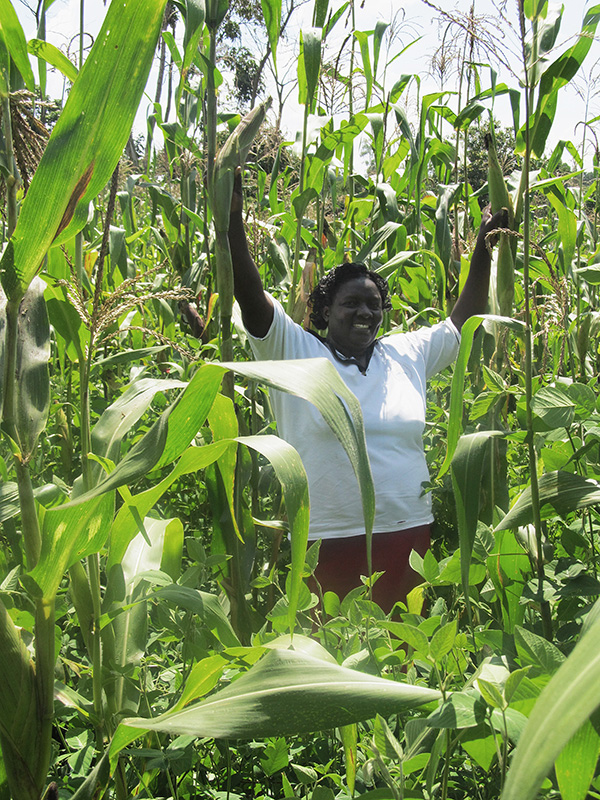Push-Pull Technology
Cereals, which include maize, sorghum, millet and rice, are the main staple and cash crops for millions of small-scale farmers in most of sub Saharan Africa (SSA). However, their production is hugely constrained by insect pests, notably stemborers, the parasitic weed known as striga and poor soil fertility.
Over the past 20 years, icipe and Rothamsted Research, United Kingdom, have developed the push-pull technology, which simultaneously addresses these three challenges. The strategy involves intercropping cereals with a repellent plant, such as desmodium, which repels or deters stemborers from the target food crop. An attractant trap plant, for instance Napier grass, is planted around the border of this intercrop, with the purpose of attracting and trapping the pests. As a result, the food crop is left protected from the pests. In addition, desmodium stimulates the germination of striga and then inhibits its growth. The push-pull technology also has significant benefits for dairy farming, since desmodium and Napier grass are both high quality animal fodder plants. Moreover, because both plants are perennial, push–pull conserves the soil’s moisture and improves its health. icipe and partners continue to test and improve the push-pull technology, to expand its agro-ecological reach, and to address any emerging challenges.
 In partnership with governments institutions, non-governmental and community based organisations, and private sector stakeholders, icipe has intensified dissemination of the push-pull technology, to ensure that its immense opportunities are made accessible to as many small-scale farmers in Africa as possible. The Centre uses a variety of pathways such as field days, farmer teachers and farmer field schools; the mass media, information bulletins, video and mobile phone technology. These tools are continuously assessed, for instance in relation to their responsiveness to gender-specific needs regarding the adoption of the push-pull technology. The findings from the reviews are then validated and applied to intensify or formulate the most effective and economical push-pull dissemination strategies.
In partnership with governments institutions, non-governmental and community based organisations, and private sector stakeholders, icipe has intensified dissemination of the push-pull technology, to ensure that its immense opportunities are made accessible to as many small-scale farmers in Africa as possible. The Centre uses a variety of pathways such as field days, farmer teachers and farmer field schools; the mass media, information bulletins, video and mobile phone technology. These tools are continuously assessed, for instance in relation to their responsiveness to gender-specific needs regarding the adoption of the push-pull technology. The findings from the reviews are then validated and applied to intensify or formulate the most effective and economical push-pull dissemination strategies.
The Centre is also optimising the push-pull technology, specifically, its adaptation to the increasingly dry and hot conditions associated with climate change. Focusing on crops grown in dry areas (mainly sorghum and millet), the researchers are identifying repellent and trap crops that can be used in a climate-smart version of the technology. In collaboration with Rothamsted Research, icipe has so far selected Greenleaf Desmodium and Brachiaria cv Mulato, as possible component crops in the climate change-adapted push-pull technology.
By end of 2014, 92,000 small-scale farmers (60% of them female), had adopted either the conventional or the climate-smart push–pull technology variants in different agro-climatic conditions and farm typologies in Ethiopia, Kenya, Uganda, Tanzania and Nigeria. Assuming an average household size of seven, an estimated 640,000 people were benefitting directly from the push-pull technology. A key development is the decision by the Ethiopian government, in 2014, to take leadership in scaling-up the push-pull technology, aiming to reach 20,000 new farmers per year.
An independent impact assessment of push-pull conducted in 2009 to establish its impact on the livelihoods of smallholder farmers, found that the push-pull technology has contributed significantly to reducing the vulnerability of farm families by ensuring higher and better yield stability. Of the assessed farmers, 75% indicated threefold to fourfold increase in maize yield. For instance, some push–pull farmers reported harvests of more than five tonnes of maize per hectare, up from previous yields of below one tonne per hectare. In addition, the farmers referred to push–pull as a ‘springboard’ for diversifying farming systems, especially through the incorporation of dairy operations using Napier and desmodium as fodder.
These benefits have contributed to increased wellbeing at household and village levels. By selling their surplus grains, milk and fodder, push–pull farmers earn extra income, which they use to pay school fees for their children, purchase household items, and improve their housing, overall nutrition and health. The study therefore suggested that push–pull is “probably the single most effective and efficient low-cost technology for removing major constraints faced by the majority of smallholder farmers in the region, resulting in an overall and significant improvement of their food security and livelihoods”.
Push–pull was also seen to contribute to national food security, rural employment, better education and increased farming knowledge. Furthermore, the impact assessment found push–pull to be an environmentally friendly technology that is likely to increase agrobiodiversity and contribute to provision of ecosystem services.
icipe’s goal is to continue scaling-up the adoption of push-pull, while addressing one outstanding challenge: making the inputs of the technology, in particular desmodium seeds, more accessible to farmers. This will involve community seed production and distribution, as well as partnerships with private sector companies to create viable commercial seed production systems.
icipe and partners are also addressing the Napier Stunt Disease (NSD), which first appeared in East Africa in the late 1990s threatening the cultivation of Napier grass, and therefore, the smallholder dairy industry which relies on it for intensive zero. NSD also hinders the success of the push-pull technology, since Napier grass is one of the key components of the technology. In collaboration with Rothamsted Research, UK, icipe has established the long-elusive cause of NSD to be a phytoplasma, and a leafhopper known as Malestas banda Kramer to be one of its vectors in Kenya. The researchers also identified two varieties of Napier grass that are resistant to the phytoplasma, which have undergone successful trials in farmers’ fields. In collaboration with farmers groups, national and research institutes, the NSD resistant Napier varieties have now been distributed to over 3000 growers (close to 60% of them women), in western Kenya.

